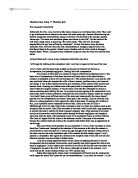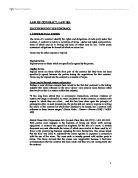- Advertisements in Newspapers and Magazines
These are also considered invitations to treat unless the advertisement is couched in terms which indicate the retailers willingness to be bound if the specified terms are accepted ie there is a promise (Carlill) rather than a mere invitation (Partridge v Crittenden [1968]).
- Advertisements appearing on the internet
Application of the same principle as newspapers and magazines.
- Display of Goods
Items appearing in retail outlets, even if the price is attached, is regarded as an invitation to treat (Pharmaceutical Society of Great Britain v Boots Cash Chemists [1953]).
Auction: AGC Ltd v. McWhirter
- Advertisement of Auctions
The advertisement of an auction is considered an invitation to treat on the part of the auctioneer. The auctioneer may withdraw items from the auction or cancel the auction all together without incurring any liability from potential bidders.
- Auctions with Reserve
Each bid represents an offer which the auctioneer may reject or accept. Acceptance of the offers occurs and an agreement is formed when the auctioneer knocks down the property to the successful bidder.
- Auction without a Reserve
Even in an auction without a reserve, each bid represents an offer that could be accepted or rejected by the auctioneer.
Tendering
An advertisement for tenders will generally be the same as an advertisement for an auction which is akin to an invitation to treat. Therefore no liability will be incurred if the person does not accept any of the tenders or even consider then in a bona fide way (Spencer v. Harding). Each tender will be considered an offer which can be accepted or rejected.
Standing Offers
A standing offer is an indication by one party of his/her willingness to provide goods over a specified period of time. An offeror may withdraw the offer, anytime, before acceptance of the offer is made in the form of an order. Further, unless the parties agree to the contrary, there is no obligation of the offeree to order goods only through the offeror, ie the offeree may choose not to accept the standing offer (Great Northern Railway Co v. Witham).
Options
If the offeree provides consideration (eg paying money) to the offeror to keep the offer open for some period, the offer cannot be withdrawn during this period. If no consideration is paid, and only a promise to keep the offer is made, the offer may still be revoked (Routledge v Grant (1828)).
Communication of an Offer
An offer becomes effective once it is communicated to the offeree (Taylor v Laird (1856)). Acceptance must take place in reliance upon an offer. If the offeree performs a particular act that corresponds to the terms of the offer without knowledge of the offer, there is no agreement, and no contract comes into existence. If it is an offer to the world at large, the offer could be accepted by any fulfilling the requirements of the offer (Carlill).
Termination of an Offer
An offer may be terminated at any time before it is accepted (Goldsbrough Mort & Co Ltd v Quinn (1910)). However, once an offer is accepted it becomes irrevocable. An offer may be terminated by:
- Revocation by the offeror
Revocation is the formal withdrawal of the offer by the offeror. Before acceptance, an offer can be freely revoked unless a promise by the offeror to keep it open for a fixed period is supported by consideration or under seal (Routledge v Grant (1828)). A revocation will only be effective once it has been communicated to and received by the offeree (Bryrne v Van Tienhoven (1880). In unilateral contracts, the offer cannot be withdrawn after the offeree has begun to perform the necessary condtions of acceptance of the offer and completion of the contract (Abbot v Lance (1860)).
- Reject by the offeree
The rejection must be communicated to the offeror before it is effective. Once rejected, an offer cannot be later accepted. If an offeree attempts to accept the offer but introduces new terms, the offeree is rejected the offer and making a counter offer (Stevenson Jaques & Co v McLean (1880)).
- Lapse of time
An offeror may stipulate that his or her offer must be accepted within a certain period of time, and if the offeree fails to accept, the offer will lapse. If no time is prescribed, the offer must be accepted within a reasonable time (Ramsgate Victoria Hotel Co v Montefiore)
- Failure of a condition subject to which the offer was made
If a condition upon which the offer is made is not fulfilled the offer will lapse (McCaul Pty Ltd v Pitt Club Ltd (1959)).
- Death
If the offeror dies and the offeree has not been notified of that death, it is still possible for the offeree to accept the offer, thus binding the offeror’s estate. If the offeree has been notified of the death he/she cannot except the offer (Coulthart v Clementson (1879)) nor can a representative of the offerors estate accept the offer on their behalf thus the offer lapses (Reynolds v Atherton (1921)).
Requirements of Acceptance
Acceptance of an offer is the expression, by words or conduct, of assent to the terms of the offer in the manner prescribed or indicated by the offer. Thus acceptance may be expressed or implied (HBF Dalgety v Morton [1987]). There are two requirements to satisfy for valid acceptance to occur:
- The offeree must agree to accept the terms of the offer
- This information must be communicated to the offeror.
Acceptance must Correspond to Offer
Offeree must have knowledge of and act in reliance to an offer
The offeree must have knowledge of the terms of the offer at the time of purported acceptance. Acceptance is not valid if two identical offers are made or if a party performs the act of acceptance without knowledge of the offer (Tinn v Hoffman & Co).
A Counter Offer is not Acceptance
If a counter offer is made, the original offer is rejected and the counter offer can then itself be accepted or rejected. Once a counter offer is made and the original offer rejected, the offeree can no longer accept the original offer (Hyde v. Wrench). A purported acceptance that departs from the terms of the offer but only in a minor non-material way may be effective and not amount to a counter offer (Turner Kempson v Camm [1932]).
Mere Inquiry does not Constitute Acceptance
After receiving an offer, an offeree may want further clarification of one or more terms. This inquiry can at most, only communicate interest but not acceptance nor rejection of an offer (Stevenson Jaques v McLean (1880)).
Notification to the Offeror of the Fact of Acceptance
The offeree must communicate acceptance of the offer to the offeror and agreement is not complete until such communication is accepted (Byrne & Co v Leon Van Tienhoven & Co (1880)).
Method of Acceptance
What is an appropriate method of acceptance in any given situation will depend on each situation, whether the offeror has outlined a specified method of acceptance with in the offer or if it is not stipulated the appropriate method of acceptance will depend on the intention of the parties as derived from the particular facts. Whether acceptance has occurred depends on whether the offeree has complied with the requirements for the method of acceptance for the particular situation.
- Method of Acceptance Stipulated by Offeror
The offeror may stipulate how acceptance should take place eg the performance of an act, return post. If acceptance does not occur in this way, generally there is no agreement.
- Acceptance by Silence
The offeror cannot stipulate silence to constitute consent.
- Acceptance by Conduct
An offeror may stipulate the manner of acceptance by advising the offeree that if he/she wishes to accept the offer, the offeree should perform stipulated acts waiving the need to communicate acceptance. Acceptance can be express or implied.
Instantaneous Communication: Acceptance must be communicated
- General Rule
When the mode of acceptance is instantaneous communication, the general rule of law is that the contract will be formed when acceptance of the offer is communicated to the offeror and that communication is received.
- Meaning of instantaneous Communication
Face to face communication, telephone conversations and telex messages are all considered forms of instantaneous communication.
Postal Acceptance Rule
- Statement of the rule
An agreement will be formed when the offeree posts the letter, not when the offeror actually receives it (Henthorn v Fraser [1892]). The rule operates only where the post is an acceptable method of communication between the two parties eg the offer was made by post or it is stipulated in the offer that the post is an acceptable method of communication (Adams v Lindsell (1818)).
- To what communication does the rule extend
The postal acceptance rule applies to forms of communication that are akin to mail but does not extend to any form of instantaneous communication, even if that communication bears some similarities to communication by post.
- Where is the rule displaced?
The rule is displaced if the court decides that it was not within the contemplation of the parties that the post was an accepted method of communication. Whether the postal rule is displaced turns the intention of the offeror. If the offeror says or implies that actual notification is required before an agreement if formed the postal acceptance rule will be displace (Bressan v Squires).
- Revocation of the acceptance prior to receipt
The agreement is formed when the offer is accepted, once accepted the offer can not be refused or revoked.
Acceptance in Unilateral Contracts
Acceptance commonly by conduct
The requirement for acceptance to be communicated is often impliedly waived. Acceptance is effected by the offeree performing the requirements specified by the offeror.
Withdrawal of an offer after acceptance has commenced
Generally, once an offeree has begun to accept the offer by performing the acts stipulated, it is likely to be too late for the offeror to withdraw the offer and claim there has been no contract formation.
Who may accept an offer?
An offer can only be accepted by the person to who it was made. Acceptance may be communicated only by the offeree or his or her agent (Powell v Lee (1908)). If an offer is made to the public at large it can sometimes be accepted by a number of people. In Carlill’s Case the offer was capable of acceptance by anyone who qualified under the terms of their offer ie anyone who purchased a smoke ball, however, in the case of a reward, while many people may have the information which qualifies them for the reward, only the first person to come forth will be eligible.







